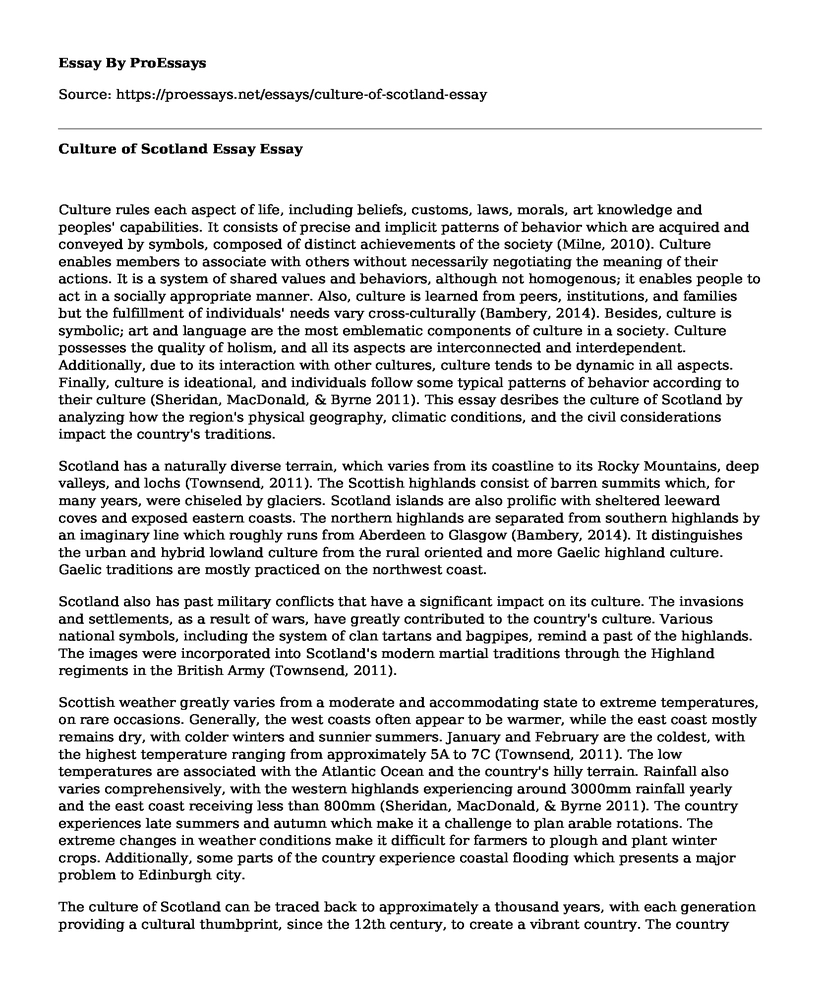Culture rules each aspect of life, including beliefs, customs, laws, morals, art knowledge and peoples' capabilities. It consists of precise and implicit patterns of behavior which are acquired and conveyed by symbols, composed of distinct achievements of the society (Milne, 2010). Culture enables members to associate with others without necessarily negotiating the meaning of their actions. It is a system of shared values and behaviors, although not homogenous; it enables people to act in a socially appropriate manner. Also, culture is learned from peers, institutions, and families but the fulfillment of individuals' needs vary cross-culturally (Bambery, 2014). Besides, culture is symbolic; art and language are the most emblematic components of culture in a society. Culture possesses the quality of holism, and all its aspects are interconnected and interdependent. Additionally, due to its interaction with other cultures, culture tends to be dynamic in all aspects. Finally, culture is ideational, and individuals follow some typical patterns of behavior according to their culture (Sheridan, MacDonald, & Byrne 2011). This essay desribes the culture of Scotland by analyzing how the region's physical geography, climatic conditions, and the civil considerations impact the country's traditions.
Scotland has a naturally diverse terrain, which varies from its coastline to its Rocky Mountains, deep valleys, and lochs (Townsend, 2011). The Scottish highlands consist of barren summits which, for many years, were chiseled by glaciers. Scotland islands are also prolific with sheltered leeward coves and exposed eastern coasts. The northern highlands are separated from southern highlands by an imaginary line which roughly runs from Aberdeen to Glasgow (Bambery, 2014). It distinguishes the urban and hybrid lowland culture from the rural oriented and more Gaelic highland culture. Gaelic traditions are mostly practiced on the northwest coast.
Scotland also has past military conflicts that have a significant impact on its culture. The invasions and settlements, as a result of wars, have greatly contributed to the country's culture. Various national symbols, including the system of clan tartans and bagpipes, remind a past of the highlands. The images were incorporated into Scotland's modern martial traditions through the Highland regiments in the British Army (Townsend, 2011).
Scottish weather greatly varies from a moderate and accommodating state to extreme temperatures, on rare occasions. Generally, the west coasts often appear to be warmer, while the east coast mostly remains dry, with colder winters and sunnier summers. January and February are the coldest, with the highest temperature ranging from approximately 5A to 7C (Townsend, 2011). The low temperatures are associated with the Atlantic Ocean and the country's hilly terrain. Rainfall also varies comprehensively, with the western highlands experiencing around 3000mm rainfall yearly and the east coast receiving less than 800mm (Sheridan, MacDonald, & Byrne 2011). The country experiences late summers and autumn which make it a challenge to plan arable rotations. The extreme changes in weather conditions make it difficult for farmers to plough and plant winter crops. Additionally, some parts of the country experience coastal flooding which presents a major problem to Edinburgh city.
The culture of Scotland can be traced back to approximately a thousand years, with each generation providing a cultural thumbprint, since the 12th century, to create a vibrant country. The country enjoys an excellent reputation for art and rich culture, ranging from theatre, music, and literature to film and dances (Bambery, 2014). The highlands retain a reference to the Celtic heritage while the southern areas reflect the Nordic and ancient Scots roots.
Most people view Scotland based on clans, kilts, and battles. The Highlanders are grouped into small clans, formed due to the land's ruggedness. Their traditional garment is the kilt, which is no longer a traditional dress. The kilt was explicitly designed for climbing the hills and a symbol of the Highlanders' culture. The Highland dress, which contains a kilt, is commonly worn at formal occasions. Besides dressing, language is also used to define the Scots' culture. Gaelic language and traditions are derived from Q-Celtic are dominant on Scotland with approximately 60000 speakers (Milne, 2010). The people also practice traditional Gaelic social gatherings (Ceilidh), which involve dancing and folk music. Scots is also commonly spoken as an equivalent of modern English with Danish influence. The combinations from Norse, Norman French and Gaelic create a diverse patchwork of regional language. However, the interaction of regional dialects and English yield a to Scottish-English continuum (Townsend, 2011). Scots is used to emphasize the political and cultural identification and social stratification. Linguistic convergence with received Pronunciation English is viewed as a sign of education and middle to upper-class status.
Scottish culture has also established a distinctive identity on graphic and performance art. The Edinburgh festival, orchestras, opera and national ballet ensure that the country maintains its artistic tradition (Milne, 2010). Traditional dances are revived through national competitive events and dedicated associations. At a more functional and popular level, textiles and jewelry uphold creative culture that allude to Celtic and Pictish design themes. Scots believe that egalitarianism is an essential requirement in the national culture.
References
Bambery, C. (2014). A People's History of Scotland. New York : Verso Books,.
Milne, N. C. (2010). Scottish Culture and Traditions. Wiltshire: Paragon Publishing.
Sheridan, M., MacDonald, I., & Byrne, C. G. (2011). Gaelic singing and oral
tradition. International Journal of Music Education, 29(2), 172-190.
Townsend, C. (2011). Scotland. Edinburgh: Cicerone Press Limited.
Cite this page
Culture of Scotland Essay. (2022, Apr 04). Retrieved from https://proessays.net/essays/culture-of-scotland-essay
If you are the original author of this essay and no longer wish to have it published on the ProEssays website, please click below to request its removal:
- Lived Experiences as a Grandparent in China
- Risk Assessment for Sports and Entertainment Venues Paper Example
- Society's Perception of Gender and the Psychological Effects of this Influence
- Descriptive Essay of My Mother
- Family Culture, Trends & Technology - Essay Sample
- Paper Example on Domestic Violence: Injuries, Control, and Children Affected
- Essay Example on Families Evolve: Changing Gender Roles and Acceptance of Different Sexualities







